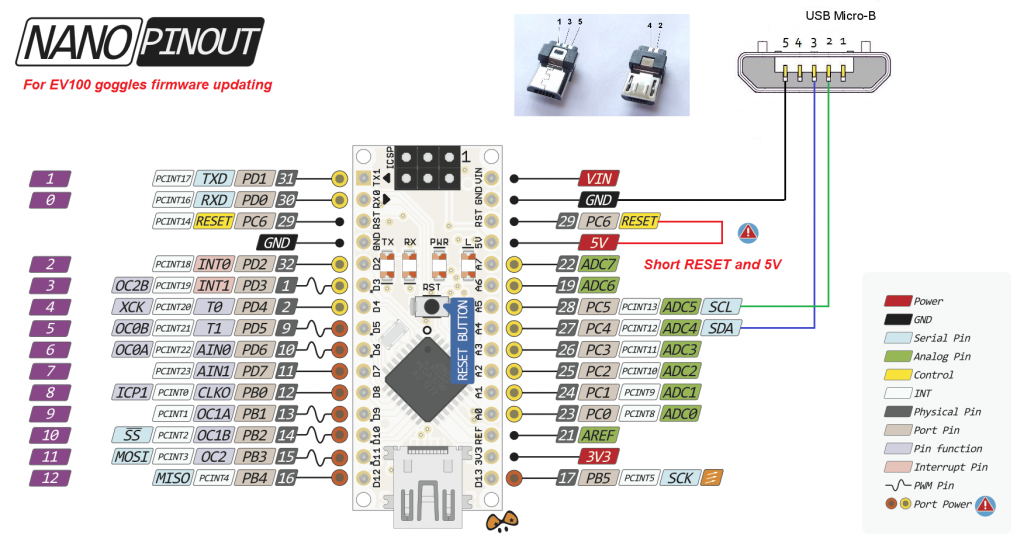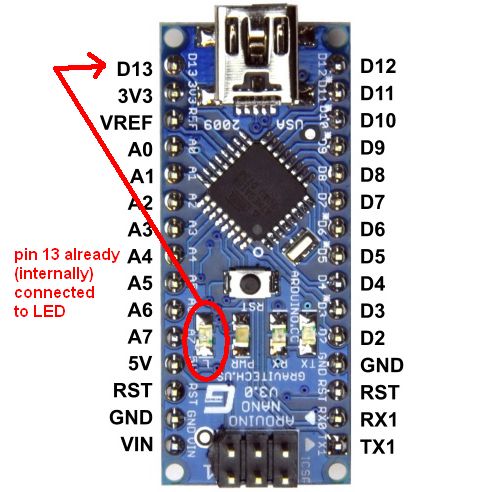
GND: The Arduino board is grounded using this pin on the board.3.3V: This pin on the board is used to deliver a 3.3V supply that is generated by the board’s voltage regulator.5V: This pin on the Arduino board is utilized to provide a regulated power supply voltage to the board as well as onboard components.Vin: This is the Arduino board’s input voltage pin, which is used to provide power from an external source.It has a lower power consumption than the Atmega328 Microcontroller. It’s widely considered as the most popular AVR controller. The Atmega328P is an 8-bit microcontroller with high speed and efficiency, based on the AVR (Audio Video Recorder) RISC (Reduced Instruction Set Computing) architecture. Standard 0.1” spacing DIP (breadboard friendly).
ARDUINO NANO PINOUT NUMBERS DOWNLOAD
ICSP header for direct program download.
ARDUINO NANO PINOUT NUMBERS SERIAL
Small mini-B USB for programming and serial monitor.Green (TX), red (RX) and orange (L) LED.Automatic reset during program download.Flash Memory: 32 KB (of which 2KB used by bootloader).Digital I/O Pins: 14 (of which 6 provide PWM output).Microcontroller: Atmel ATmega328 SMD Package.Both UNO and Nano are based on ATmega328P Microcontroller but Nano is significantly smaller in size compared to UNO. After Arduino UNO, the most popular board in the Arduino line-up is probably the Arduino Nano. The Nano board is designed in such a way that the pins are breadboard friendly so that you can easily mount it on one for your DIY projects. As the DC Power Jack is not available on this Board, power can be given through Mini USB Cable. It also supports serial communication using Tx and Rx pins. Each pin operates at a voltage of 5V providing a maximum of 40mA. This Arduino board lacks a DC power jack.

Out of 14 I/O ports, 6 pins were used for PWM output. And an Atmega328 microcontroller is used to connect with external electronics circuits. Meanwhile, the current version of Arduino Nano comes with a mini USB port.The current version of Arduino Nano comes with 14 digital I/O pins, 8 analogue pins, an ICSP header, 16 MHz ceramic resonators. The Atmega328 has a built-in bootloader, which makes flashing the Nano board with a programme simpleĪrduino Nano version 3 is an open-source small embedded development board based on the Microchip ATmega328 SMD package developed by Arduino. It is based on the ATmega328 8-bit microcontroller by Atmel (Microchip Technology). The Arduino Nano development board is one of the most popular Arduino boards, having been introduced in 2008. Here, we are going to discuss about one of the popular microcontroller Arduino Nano, what is this about, the main features, working, technical specifications and everything you need to know.

Designed with the purpose of making our tasks easier, with minimum effort, and gives maximum output. A Microcontroller was introduced as a new innovation in the electronics industry. Nowadays the electronic devices are becoming compact, flexible, and cheap that are capable of doing more function as compared to their predecessors.


 0 kommentar(er)
0 kommentar(er)
